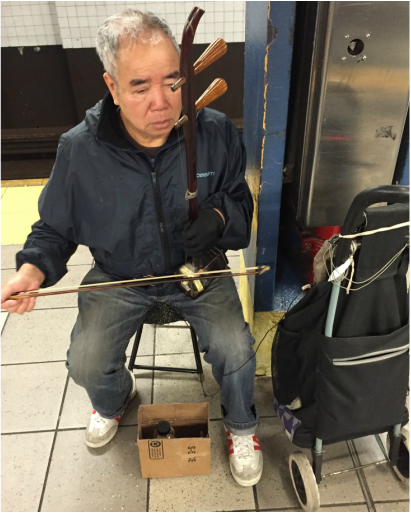|
I look and listen for this man whenever I change subway lines at Roosevelt Ave. in Queens. I often find him midway on the Manhattan-bound platform, facing the E and F trains. In quiet moments I hear the melancholy strains of the erhu, a two-stringed Chinese violin. The chords convey the vastness of China, the long history, the pain, the hope. His own story, I do not know. He keeps his head down, plays to the beat from a mobile speaker. He puts a modest cardboard box between his sneakers. I stand up close. His China is not the neon-and-skyscraper China I encountered at the 2008 Olympics in Beijing, after they bulldozed most of the hutongs, the old neighborhoods. I take a few photos on my iPhone. He does not seem to notice. I drop $5 in the box and say “Xie Xie” -- thanks, in Mandarin. He says, “Thank you.” Then my train arrives.
Joshua Rubin
10/26/2016 09:55:21 am
There are quite a few erhu players amongst the subway buskers in our vast system. There used to be a guy who teamed up with a Dominican accordianist, and they played each other's traditional songs and some American standards. Very sweet. There is an [erhuist?] regularly at the Jay Street stop in Brooklyn who plays Jingle Bells all year long, except that he plays "oh what fun it is to ride" as an F# and gets stuck there for three extra bars. Drives me crazy. I give him money anyway. Can any of you Chinese linguistic scholars teach me how to say "I will pay you double if you can fix that F sharp?"
George Vecsey
10/26/2016 12:00:48 pm
Josh: There is a more formal way, but I thought I would try to keep it simple. (Ummm, actually, I used Google Translate This is nothing if not a full-service web site. GV.)
Joshua Rubin
10/26/2016 03:05:33 pm
Thanks, George, but I would be afraid to actually say it. One wrong intonation and I'd be punched in the nose.
George Vecsey
10/26/2016 04:17:34 pm
Josh: I'm sure they can. 10/26/2016 04:25:21 pm
Subway musicians are great. The IRT 2 & 3 always had a variety of cultures and skill levels.
George Vecsey
10/27/2016 09:27:29 am
Alan, no buskers in the Berkshires?
Brian Savin
10/27/2016 09:02:06 pm
I played a lot of Erhu music on Apple Music today, with a lot of enjoyment. Once again, George, you taught me something worthwhile. Thanks.
George Vecsey
10/28/2016 10:28:31 am
Brian, You're the guy who got me reading the Theodore Roosevelt biography, so thank you. 10/31/2016 05:42:29 pm
Yo Yo Ma is an amazing person.For all his fame, he is a regular down to earth guy.
bruce
10/30/2016 07:59:31 pm
George,
George Vecsey
10/31/2016 10:53:37 am
Bruce: It was "The Rise of Theodore Roosevelt," by Edmund Morris, the first of three. It takes him to being out in the woods and being told that President McKinley had died. I met Roosevelt's daughter Ethel Derby, around 1973. We live half an hour from his home in Sagamore Hill, and my friends Brian and Janet Savin invited us for a tour of the home. I wrote about it on this site:
bruce
10/31/2016 12:57:08 pm
George, 10/31/2016 06:38:31 pm
“The Bully Pulpit: Theodore Roosevelt, William Howard Taft, and the Golden Age of Journalism” by Doris Kearns Goodwin is an interesting book on many levels. It not only covers the man, but also the age in which he lived.
bruce
10/31/2016 07:12:50 pm
it's hard to escape your time, innit? I loved Churchill, but some of his beliefs--white man's burden for example--don't fit very well today, do they? I enjoyed kearns Goodwin's bio. have a few of her books....
Alan Rubin
11/1/2016 11:21:58 am
I agree that “Trader” Lane was not a true baseball man.
bruce
11/1/2016 01:15:33 pm
alan, 11/30/2016 05:03:33 am
<a href="http://newyear2017.site/">New Year 2017 Wallpaper Free Download</a> Comments are closed.
|
Categories
All
|










